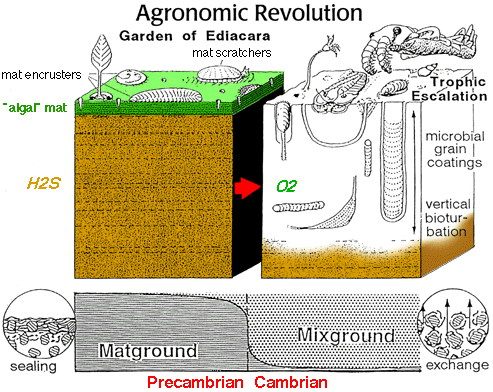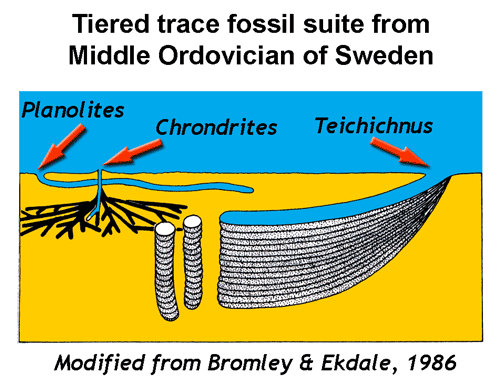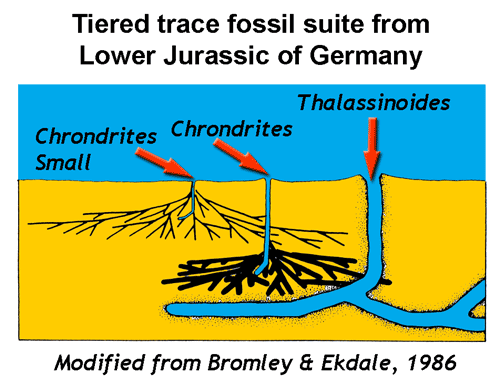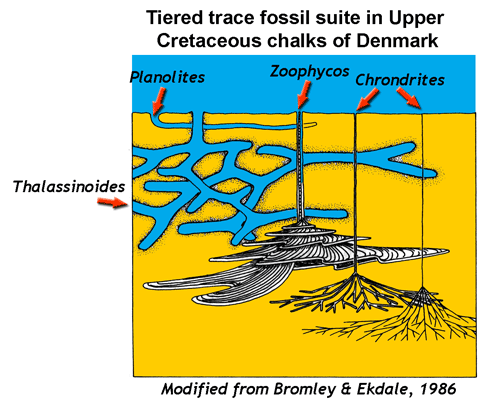|

.gif)

firm grounds
ichnofacies
ichnofossils
parasequence
trace fossil literature .pdfs
|
Ausich and Bottjer, (1982) and (1986), (click on "tiering" link to left) recognize tiering as a common community structure and strategy of the geologic past. They demonstrate how different suspension feeding organisms were distributed vertically in space above and just below the sediment surface. They propose that organisms used their vertical position in the water column to acquire a food supply and maintain the ambient conditions necessary for their life. These tiering settings and organisms were:
Primary Tierers – suspension feeders that have a body or burrow that intersects the seafloor.
Secondary Tierers – suspension feeders that maintain a position above or below the sediment-water interface and utilize a support structure or a burrow of a primary tierer or a plant living in that setting. Ausich and Bottjer associate this tiering with an epifauna of benthic organisms living on or above the sediment-water interface and infauna of benthic organisms living below the sediment-water interface.
Using the concepts of Ausich and Bottjer, (1982), Bromley and Ekdale (1986) record how burrowing organisms have a strategy of vertical tiering their burrows at and below the sediment surface that is in response to their individidual sensitivity to sediment dynamics, coherence of the sediment, the local salinity, oxygen levels, food sources and predation.
They showed how shallow burrowing organisms lived in the watery uncompacted sediment while the deeper burrowers occupied a stiffer, compacted firm ground sediment. Bromley and Ekdale (1986) established that this vertical tiering of the ichnofacies can be modified if more sediment buried the existing faunal assemblages. This would tend to force the burrowing organisms to migrate up through the tiered suites of trace fossils overprinting earlier shallower burrows. Featured below are some examples of ichnofossil tiering and how it manifests itself through time.


 
Cross cutting relationships of juxtaposed shallow and deeper burrowers enable geologists to determine the order in which the burrows were formed and so trace the evolution of this shallow subsurface milieu. Bromley and Ekdale (1986) note that the best preserved and best displayed trace fossils are associated with the assemblages found in the deepest tiers.
The use of the concept of tiering, combined with the identification of the ichnofacies assemblages proposed by Seilacher (1967) enhances our ability to determine how stacked parasequences accumulated in ancient depositional systems and acquired their geometries. Frey and Pemberton, (1985) and the Ichnology Research Group (IRG), lead by George Pemberton, at the University of Alberta in Edmonton Canada have detailed strategies on how to do this: link by clicking on the IRG Logo to left.
References
Ausich, W. I. and D. J. Bottjer. 1982. "Tiering in suspension feeding communities on soft substrata throughout the Phanerozoic." Science. 216:173-174.
Bottjer, D. J. and W. I. Ausich. 1982. "Tiering and sampling requirements in paleocommunity reconstruction." Proceedings of the Third North American Paleontological Convention, 1:57-59.
Bottjer, D. J. and W. I. Ausich., 1986. "Phanerozoic development of tiering in soft substrata suspension-feeding communities": Paleobiology, 2:400-420.
Bromley, R. G. and A. A. Ekdale. 1986. "Composite ichnofabrics and tiering of burrows." Geological Magazine, 123:59-65.
Frey, Robert W., and S. George Pemberton (1985), Biogenic Structures in Outcrops and Cores. I. Approaches to Ichnology, Bulletin of Canadian Petroleum Geology, Vol. 33 No. 1, Pages 72-115
Seilacher, A. 1967 "Bathymetry of trace fossils" Marine Geology v 5 p 413-428
|